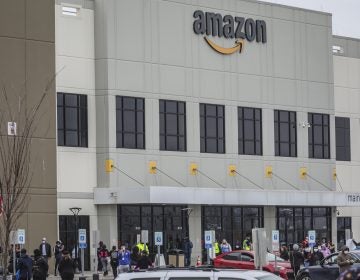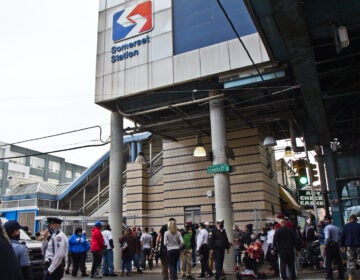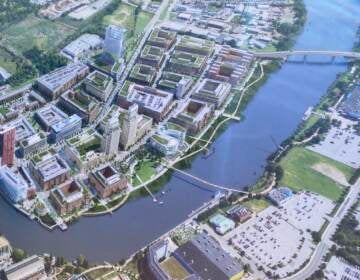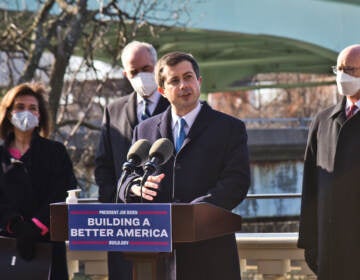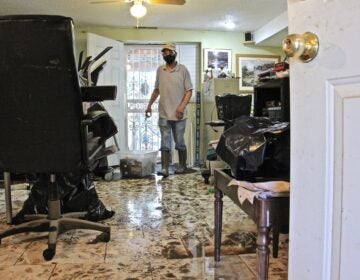New trolleys, safer streets, e-buses: Philly could benefit from Biden’s infrastructure plan
Here is what Biden’s new plan could mean for Philadelphia’s future, according to four local transportation experts.
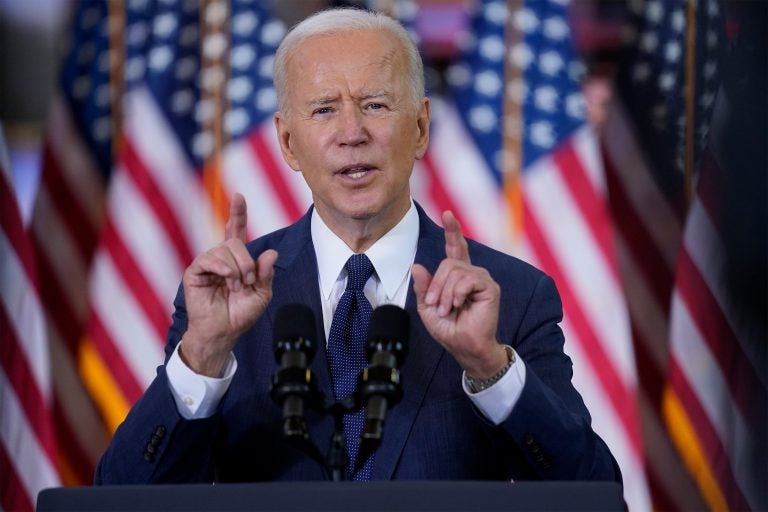
President Joe Biden delivers a speech at Carpenters Pittsburgh Training Center, Wednesday, March 31, 2021, in Pittsburgh. (AP Photo/Evan Vucci)
President “Amtrak Joe” Biden promised to prioritize infrastructure and now, he has come out with a $2 trillion proposal for a far-reaching series of investments in roads, bridges, transit, aging school buildings, wastewater, broadband, and housing. Higher corporate taxes would fund the investment.
The plan, White House press secretary Jen Psaki said, is “about making an investment in America — not just modernizing our roads or railways or bridges but building an infrastructure of the future.”
Included is $115 billion to modernize bridges, highways, and roads that are in the worst shape. The president aims to upgrade 20,000 miles of highways, roads, and main streets and fix the 10 “most economically significant bridges in the country in need of reconstruction.” The same goes for 10,000 smaller bridges that are vital to connecting communities.
Biden has set aside $20 billion for safety programs and fixes, including Vision Zero initiatives and other improvements to reduce crashes and fatalities, especially for cyclists and pedestrians.
If the proposal can make it through both congressional chambers, transit agencies can look forward to support for expanding into new communities — and an additional $85 billion to help address repair backlogs.
Another $80 billion would go to modernize Amtrak’s Northeast Corridor line, a connector relied on by many Philadelphians for recreational travel and commutes to work.
Also tucked into the package: $20 billion for communities like Philadelphia’s Chinatown and Wilmington’s West Side that were divided by highway projects.
Philly, with support from PennDot, the Federal Highway Administration and local foundations, has already put $225 million toward capping I-95 at Penn’s Landing but calls from Chinatown to cap the Vine Street Expressway have never advanced.
All that said, here is what Biden’s new plan could mean for Philadelphia’s future, according to four local transportation experts.
Note: The following statements have been edited for clarity.
Andrew Busch, spokesperson for SEPTA
Overall, our hope is that an infrastructure package, coupled with the upcoming federal funding reauthorization, will provide more resources for us to accelerate efforts to tackle state of good repair projects — core infrastructure work in the capital program, and also lay the foundations for the bigger projects of significance.
That would include trolley modernization, improvements to the Market-Frankford Line that would allow for increased capacity, completing [accessibility] work on both the MFL and Broad Street Line and King of Prussia Rail — the big projects that are well into the hundreds of millions and/or billion-plus [dollar range] that we don’t have a way to fund with our current capital budget.
Electric buses are certainly a priority as well, particularly as we advance with the Comprehensive Bus Network Redesign, but we are already looking at ways to move that forward within our existing budget.
Camille Boggan, Philadelphia resident and transit advocate

The plan is definitely ambitious, although it still allocates a lot of money towards maintaining or expanding car-centric infrastructure while being branded as a climate plan. Over $160 billion is promised to rail and transit (though this doesn’t seem to include anything about high-speed rail), but there’s also $174 billion to encourage electric vehicle use by reducing the price of EVs.
Adding more cars on the road, even if they’re electric, is not the answer to long-term climate resilience. Furthermore, there is only $20 billion promised for safety improvements, with no specifics aside from funding Vision Zero programs. There’s absolutely an opportunity to include explicit interventions or guidelines for improving road safety.
The additional $85 billion for transit agencies after the COVID-19 emergency package will be huge for reversing service cuts and making much-needed upgrades. I hope to see U.S. transit agencies take a closer look at who their consistent riders have been throughout the lockdown periods and use this funding to make a much needed shift away from focusing service on 9-to-5 demand. For those agencies facing severe revenue losses from their commuter rail networks, this could be an opportunity to reform them to function as high-frequency rail, taking advantage of the changes in network demand.
Sarah Clark Stuart, executive director of Bicycle Coalition of Greater Philadelphia

Generally, biking and walking infrastructure is rolled into road and bridge programs. We would like to see the portion of highway funding that’s dedicated to biking and walking be increased. It’s been proven over and over again that there is no other way to incentivize and encourage more people to bike and walk, instead of driving. And so we need to have more funding being dedicated to building protected bike lane networks and off-road trail networks that truly allow people to get from their home all the way to their work or their school safely. That’s number one.
Number two is by building better bicycle and walking infrastructure, whether it’s lanes or sidewalk networks or trail networks, we’re going to increase safety not only for bicyclists and pedestrians, but also for motorists. And that’s going to reduce the kinds of crashes that kill people, by building traffic calming right into the roadway network. So having money be dedicated to Vision Zero is incredibly important and needed to bring down the number of people who are killed every year from around 40,000 down to zero, which is where it really needs to be.
And then third is by prioritizing transit as a mode of transportation that’s going to dramatically change the transportation sector’s impact on climate and by improving systems, modernizing them, expanding their reach to really reach more people and provide more daily life accessibility through transit, that’s really going to change how people move and going forward over the next couple of generations.
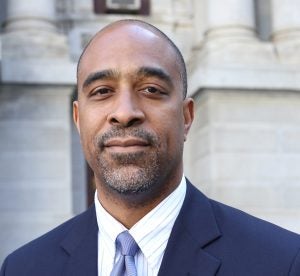
Michael Carroll, deputy managing director of Philadelphia’s Office of Transportation, Infrastructure, and Sustainability
We’re certainly having great conversations with SEPTA, the airport, the ports, DVRPC, School District, Chamber of Commerce, PennDOT, everybody. And the excitement is just palpable that we’re going to be able to, hopefully, take on so much good work, important work, essential work now that the one thing that had always been missing, which was the funding commitments, is hopefully going to be appearing and we’ll be able to back up all the words that have been coming down to all levels of government about infrastructure for so long.

Subscribe to PlanPhilly
WHYY is your source for fact-based, in-depth journalism and information. As a nonprofit organization, we rely on financial support from readers like you. Please give today.



